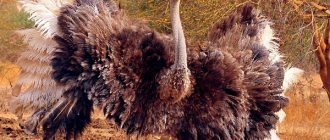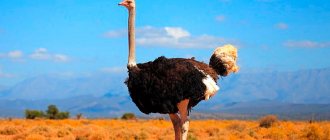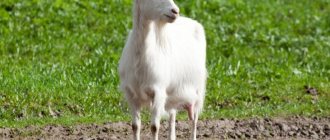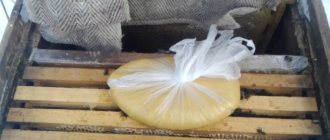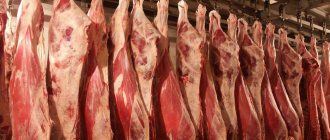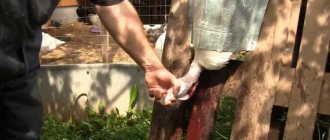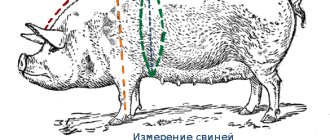Home » Articles about ostriches » How to kill an ostrich
Before you kill an ostrich, you need to make sure it has reached its optimal weight. Proper pre-slaughter preparation guarantees the preservation of good quality meat, since its taste will not be spoiled due to the release of adrenaline. The slaughter must be carried out by a person with experience - sensing danger, a strong bird is capable of killing.
How long does an ostrich grow before slaughter?
Ostriches are slaughtered after they have gained sufficient weight. Since this process depends more on the food supply than on age, they are guided by body weight. Males are sent for slaughter after they gain 120 kg of live weight. Since they are not used to produce eggs, there is no point in keeping them further. Females are considered ready for slaughter if they weigh 100 kg.
To obtain high-quality meat in the required quantity, ostriches are raised for about two years, after which, immediately before slaughter, they are actively fed with high-calorie feed.
Benefits of ostrich breeding
Let's consider the benefits of business in terms of money:
| Products | Sales price, thousand Russian rubles. |
| Chick: | |
| one-day event | until 9 |
| up to 30 days | 10-12 |
| 30-60 days | 12-15 |
| six months | 20-25 |
| yearling | 30-40 |
| Ostriches 2 years old | 60-70 |
| Sexually mature from 3 years | 90 |
| Family, 3 pieces | 300 |
| Egg: | |
| incubation | 3 |
| dining room | 1 |
| souvenir | 0,5 |
| Fat, 1 kg | 1 |
| Meat, 1 kg | 0,6-0,7 |
| Leather (1.2-1.4 sq. m): | |
| wet salted | 3 |
| crafted | 7 |
| Feather, 60 cm | 0,4 |
What you need to know before slaughter
An ostrich differs from a chicken not only in size, but also in character. If you have just started breeding these birds, then you need to learn a few important rules that will help you not only quickly complete the operation, but also avoid serious injuries.
Video: how to properly kill ostriches
- Don't underestimate the power of ostriches . Animals are distinguished not only by their large size, but also by the presence of well-developed muscles, so in no case should you frighten or hit the bird immediately before slaughter. An adult ostrich may well break your bones and also damage your internal organs.
- He who grows it slaughters it . In rural areas there is always a person who kills wild boars. A specialist in his field slaughters a pig quickly and without unnecessary problems. It won’t be possible to do something similar with ostriches, since these birds get used to one owner, who is forced to slaughter. At best, the bird will not allow a stranger to come near it, and at worst, it will seriously injure it. For this reason, you need to make sure that the ostriches get used to you, otherwise you will have to organize a real hunt.
- Stress and its consequences . Slaughter is always carried out far from the place where the livestock is kept, otherwise you will be faced with the fact that the ostriches, who are accustomed to you, will never let you near them again. If the birds see how you mock their “brother”, then in the future you will not be able to gain any favor from them.
Breeding process
A positive feature of ostriches is their high adaptability - unpretentiousness and adaptability. They are able to withstand annual temperature fluctuations from -20/25°C to +30/35°C, which makes it possible to breed ostriches in Siberia. Birds are quite unpretentious both in terms of diet and living conditions, which makes caring for them not very difficult, provided that pens and ostrich fowls are properly constructed and a balanced diet is provided for the birds.
Conditions of detention
In order to breed ostriches, a number of conditions must be met.
The room where the livestock is located should be well ventilated and lit. The presence of dampness, mold, and, of course, the absence of rodents (mice, rats, etc.) is unacceptable. Windows must have dimensions of at least 800/800 mm and be located at least 1 meter from the floor, because daylight hours for pets should be 14-15 hours. Given the growth of ostriches, special attention must be paid to the height of the room. The height of the ceilings must be at least 3-3.5 meters, in exceptional cases +1 meter from the height of an adult. The floor should be densely covered with dry straw, the walls should be plastered and whitewashed.
In addition to the premises, keeping ostriches involves creating an enclosure for walking. When constructing it, the following requirements are taken into account. It is recommended to place the site on soft, sandy soil, or additionally fill it with sand or fine gravel. Most of the territory should be well lit by the sun, with shaded areas provided. The fence of the enclosure must be at least 2.5-3 m high. If the perimeter is covered with a mesh, then the size of the cells should not exceed 30x30 mm, which will prevent the bird from getting “stuck” in the mesh and suffocating.
Feeding
Despite the fact that ostriches can be classified as omnivores - they can eat both food of plant (leaves, grass, seeds) and animal origin (small lizards, insects), you should not feed these birds just anything.
Before we tell you what food you can give, let’s look at the restrictions:
- It is strictly forbidden to add to the feed:
- parsley;
- rye;
- potato.
- Allowed in limited quantities:
- cabbage;
- bran;
- flour.
Having excluded what is harmful for the bird, we create a diet. The menu should be dominated (at least 50%) by so-called “green food”, the rest should be combined food. The daily requirement of an adult is 2-2.5 kg of feed. It is recommended to include in the diet:
- grasses - alfalfa, rapeseed, clover;
- coarse silage - straw, hay;
- various vegetables/fruits - pumpkin, carrots, zucchini, apples;
- grains - corn, sunflower, wheat;
- bone, fish meal;
- mineral supplements, vitamin (limestone, calcium, etc.).
Separate attention should be paid to the provision of water, especially in the hot season. The daily requirement of an adult ostrich is 10 liters, and it cannot get this amount from food.
The best option is to install drinking bowls near feeding areas. Taking into account the growth of birds, the drinking bowl should be located at a height of 70-80 cm from the ground.
Possible diseases
One of the biggest troubles awaiting the farmer is the diseases to which the domestic ostrich is susceptible. In order to contact a veterinarian in a timely manner, you should know the most common diseases. This list is not exhaustive, it shows only the most common problems:
- bird flu
- smallpox
- mycoplasma
- respiratory diseases
- Newcastle disease
- botulism
- leg deformities
- skin parasites
- worms, etc.
Reproduction
Ostriches reach sexual maturity: in males at 25–31 months, in females at 19–25 months. The ability to reproduce remains for more than 30 years (until the age of 35). Males are polygamous - for normal reproduction it is necessary to maintain such proportions of the population so that for every male there are 2-4 females. Reproduction of ostriches requires that females be younger than their partner - this option increases the hatchability of eggs.
The male’s readiness to reproduce will be indicated by his “appearance” and behavior. During this period, the skin of the legs and the area around the beak turns red, and the male himself begins to flap his wings and stretch his neck, attracting the attention of his partners. During the mating season (laying period), which lasts 4-5 months (from May to early autumn), males are very aggressive - you should be extremely careful when interacting with them.
During the season, the female lays eggs every 2-4 days. Under natural conditions, the incubation period for eggs lasts on average 41-46 days; for emus this figure is higher - 52-56 days. In this case, both partners take part in the process alternately. During the season, one female can hatch up to 20 chicks.
However, incubators are used to increase the number of birds on farms.
Incubation
To speed up the process of reproduction of young animals, increase the number of birds hatched, and also reduce the risk of pathologies, incubators are used.
According to statistics, the highest percentage of hatchability of chicks is produced by clutches of females of the 2nd-3rd season; clutches of the first season, as a rule, contain a high rate of unfertilized eggs. It should be taken into account that young females are capable of laying up to 20-25 eggs per season, and at the age of 7 years about 60.
The average clutch rates of 6-7 year old females are as follows:
- fertilization rate – 65-70%;
- hatchability – 79-88%;
- survival rate of young animals is 66-81%.
The hatching period in the incubator is about 42 days. During this period, the temperature is artificially maintained within 35–36°C and humidity 30–33%. In the first ten days, eggs must be turned every 3 hours, and then every hour. At the 39th week, the eggs are placed in a hatcher, where they remain until the chicks hatch.
Particular attention must be paid to the moment the chicks appear. In nature, ostrich offspring appear almost simultaneously. The “signal” for the birth of ostrich chicks is a special sound made by the male ostrich and the tapping of neighboring ostrich chicks. With artificial hatching, this process is stimulated by playing a specially prepared sound track, but the process of chick emergence still takes 1.5-2 hours.
How to properly kill an ostrich
Let's consider the features of slaughter, as well as preparation for this procedure. We will talk about mass killing, which is carried out in slaughterhouses, as well as about methods of slaughter at home.
Preparation
You need to have the following tools:
- special stunning hammer;
- sharp knife;
- large metal hook for hanging;
- thick rope.
Slaughter process
Killing poultry is divided into several stages, which must be performed sequentially so as not to spoil the product and not waste extra time.
Stunning a bird
In large workshops, ostriches are stunned using an electric current with a voltage of 240 V, which is applied for 6–7 seconds. This allows you to immobilize several individuals at once. At home, a stunning hammer is used to hit the bird on the head. The blow must land exactly in the center of the head in order for the bird to switch off. Otherwise, you will have a hard time, as the angry ostrich will try to get out of the room or attack you.
Bleeding
After stunning the ostrich, the jugular vein, which is located in the neck, is cut, or the head is completely cut off. Next, using hooks, the carcass is hung upside down so that the blood flows faster than the glass. Only after all the blood has left the body can the next stage begin. Experienced breeders cut the main artery, which is located near the heart. This allows you to speed up the entire process, since the liquid comes out under pressure.
Plucking
After slaughter, it is necessary to properly pluck the ostrich. To do this, it is recommended to invite a specialist who will carry out this procedure, allowing you to subsequently sell the undamaged product. If a novice does the plucking, then the collected feathers will be of poor quality, which will make selling them problematic.
Video: plucking an ostrich It is important not to damage the skin during plucking. Even the slightest tear will significantly reduce the cost. Since leather is sold in squares, you may lose profit altogether.
How to butcher an ostrich?
After plucking, they move on to the skin. When removing, the cut lines must be very precise, otherwise this may later reduce the quality of the meat.
The skin must be removed quickly so that it does not deteriorate.
It is carefully cut off with a sharp knife, passing along the abdomen, the inside of the wings and legs. After stripping, remove excess fat. If intestinal contents or droppings remain, the skin is quickly washed. After this they are salted. The weight of salt should be 2 times the weight of the skin itself. It is then cut and stacked for 60 hours.
Next, the scalp is preserved. If it is too dehydrated, meaning it has less than 15% moisture, it begins to crack and become brittle. Such material will not be sold at a high price. The procedure is carried out in a dry, ventilated room with a waterproof floor. After canning, the skin is stored in a refrigerator.
Ostrich cutting is carried out on a high-quality wooden surface. It consists of dividing into quarters, half carcasses, thighs, drumsticks and boneless meat.
In this case, the cuts are made so as not to touch the muscles. Only in this case will you get ideal meat for fillets and steaks.
The ostrich is butchered quickly while the protein structure of the tissue is preserved. At the end, small muscles and trimmings remain, which are sold as low-grade meat.
Leather dressing: processes
After plucking, the skin must be removed so that it can be further processed and sold. No one will buy small torn flaps, so it is important to familiarize yourself with the specifics of separating the cover from meat and bones.
Skin removal
Immediately after removing all feathers, you must immediately begin to separate the skin:
- To do this, cuts are made in the center of the abdomen, as well as on the inside of the legs and wings. Remove carefully using the blunt side of the knife. The skin should have a shape close to a square.
- If there is excrement, fat, meat or unprocessed food residue on it, then all of the above should be removed before canning.
- Next, the skin is laid out on a clean surface to cool.
Skin removal
Removing the skin is one of the most critical stages. This material brings good income to the farmer, so it is important to prevent defects from occurring.
It is better to entrust the work to a specialist. If this is not possible, you will have to do it yourself. Continuous cuts are made:
- along the wings (from one edge to the other through the stomach);
- from the anus to the beak;
- from the distal joint along the thigh, towards the abdomen.
The skin is carefully removed and left to cool for 15 minutes. After this, it is washed from dirt, the remaining fat and meat are removed with a dull knife, and it is salted (canned). This stage is necessary in order to remove excess moisture and prevent the development of bacteria. The skin is spread inside out and sprinkled with coarse salt 1:2. The raw materials are kept in the refrigerator for 60 hours.
Normally, the amount of moisture in the leather that will be tanned should be at least 15%. Excessively dry skin becomes too fragile and gets damaged in the future. Dressing includes the following stages:
- soaking with four times replacement of the composition, the process takes 48 hours;
- drying;
- stripping (use a dull knife or scraper);
- soaking in an acidic composition for 24 hours;
- tanning for 24 hours in a solution that has tanning properties (aluminum-chromium alum or other compounds are used);
- final drying in a straightened form (the process takes about 48 hours);
- final processing (polishing) – the procedure adds shine and smoothness.
After this stage, the skins are sorted, the price depends on several factors:
- size (the largest size is obtained by releasing adult males for slaughter);
- quality of preparation and preservation (there should be no traces of fascia and fat, complete dehydration is not allowed);
- presence/absence of defects (depends on the experience of the person involved in skinning - skinning).
Proper slaughter of ostriches for meat
African black ostriches are more suitable than other species for breeding in our country with its harsh winters and cold weather. Raising them on a farm is a profitable business - there they lay eggs, hatch their offspring, and when the time comes, they are slaughtered for meat. Emus are also bred on the farm. Every farmer knows how to properly slaughter an ostrich.
Meat is one of the main products of ostrich breeding
Main breeds of ostriches and their weight
These birds feel good not only in natural conditions, but also on farms, which has made it possible to tame them quite strongly and raise them for agricultural purposes.
We also recommend reading: How much does half a carcass of pork weigh When turkeys start laying eggs at home - the benefits of eggs Emu ostrich: where it lives, what it eats, interesting facts Dove chick. The birth of a baby pigeon and its development
Domestic ostriches, which you can see on farms, are distinguished by their impressive dimensions and equally decent weight.
Nifulin Forte for the treatment of birds
What are the benefits of raising exotic birds?
The ostrich (emu, African, Somali) is the largest bird in the world. Some males grow up to 2 and a half meters, and their average weight is 150 kg. Females are smaller in size and weigh no more than 120 kg. At one year of age, an ostrich weighs about 120 kg and is quite ready to be slaughtered for meat. This is best done in a special slaughterhouse, which is equipped in each farm. Emus are slightly smaller than African ostriches.
There is currently a shortage of ostrich meat on the meat market. To provide for everyone, it is necessary to increase its production 10 times. Farmers have not yet been able to feed the thirsty with dishes prepared from exotic ostrich meat. On the farm, large birds feel no worse than in the wild: they lay eggs and reproduce quickly. One female lays about 80 large and tasty eggs during the year.
The Australian emu is also bred for meat.
Business plan
To properly organize a business, you should clearly draw up and work out a plan. In your business plan, you need to describe and calculate all the steps that will be taken when organizing an ostrich farm: starting from the breed of ostriches, their quantity, equipment of the pens, purchasing the necessary devices and equipment, ending with determining the market for the finished product.
Which breed to choose for breeding
When choosing ostriches for breeding, it is necessary to study the strengths and weaknesses of the breed and their characteristics.
African ostriches are the largest breed, weighing up to 150 kg per individual. They are distinguished by black (black and white) color of feathers, height reaches 2-2.5 m. Unpretentious to living conditions and climate (optimally up to +25°C), friendly. Depending on the subspecies (Namibian, Zimbabwean or Masai), they produce from 40 to 70 eggs weighing 1.5-2 kg each per season.
Emus are representatives of the Australian continent. The second, after African relatives, in size, reach a weight of 70 kg. They have gray (light brown) feather color, height - 1.9-2m, peaceful. The female lays 7-8 small eggs at a time (up to 0.8 kg each).
Rhea - inhabitants of South America, reach a weight of 40 kg. Externally they are similar to their African brothers, except for their height - only 1.5 m. The most productive breed - each clutch contains up to 20 eggs, each of which weighs 1.2-1.3 kg.
Necessary costs and time
After you have chosen the breed of ostrich that you are going to breed, we monitor poultry prices. Prices for ostrich stock depend on the age of the bird (price per unit):
- chick 2-4 weeks old - 9-12 thousand Russian rubles;
- one-year-old individuals - 40-50 thousand Russian rubles
Ostrich family (3 mature individuals over 3 years old) - can be purchased for 300 thousand Russian rubles.
In addition to purchasing the birds themselves, the new farmer must also take care of building housing for the pets and providing them with the necessary enclosures and pastures for walking. Purchase the necessary equipment for feeding (choppers, feeders, drinking bowls, etc.) from the veterinary control service.
It should be remembered that providing food for pets will now become a daily responsibility, which will constantly replenish the farmer’s expenses. In addition, do not forget about the costs of a veterinarian, electricity, water, heating the premises in the winter month, etc. In general, you need to prepare for the fact that for the first 1-1.5 years the expenditure side will prevail.
Why are ostriches not slaughtered on the farm?
Birds are not slaughtered on a farm: birds react inadequately to stress. They start to panic, run away and break everything they come across along the way. Therefore, people who slaughter them must know all the intricacies of caring for birds. With proper care, you can achieve good reproduction of ostriches and prosperous business.
Farmers first use electric shock to euthanize the birds. This is done with special equipment that only a large farm can afford to purchase. Another method: the bird is stunned by hitting it on the head, after which the aorta is cut and the blood is allowed to flow out.
Preparation for slaughter
In order for poultry slaughter to go smoothly, it is necessary to take into account some nuances.
- The ostrich is distinguished by its large size (grows up to 2.7-2.9 m) and extraordinary strength. In case of danger, it can cause serious injury to a person. Therefore, the bird should not be frightened before slaughter.
- The feathered giant gets used to those who feed him and look after him; he trusts only these people. He won’t let strangers get close to him. The appearance of a stranger will alarm the bird. This is why slaughtering should not be trusted to outside experts.
Before killing an ostrich, you need to prepare the slaughter room and tools:
- hammer;
- well sharpened knife;
- strong rope;
- hook to hang the carcass.
Instead of a hammer, you can use a stun gun to immobilize cattle or pigs. This is justified on large farms, because... The equipment is not cheap, or you can rent the device.
What you need to know about ostriches for their slaughter
- Ostriches are unpredictable birds that lend themselves well to taming. This is their positive feature, because otherwise it is impossible to slaughter them for meat. Every owner of an ostrich farm knows that in order to find contact with a bird, a person must become its breadwinner and drinker, and communicate with the ostrich as often as possible. Young ostrich chicks are more easily tamed to the people caring for them. Killing an ostrich that is accustomed to you is very simple - just move it further away from prying eyes, and then, using an electric current, a gun, a hammer and a knife, carry out this bloody task. To bleed a bird, it is hung upside down by its legs and the skin and feathers are removed. Emus are a little more difficult to train than African ostriches.
- It is necessary to be able to correctly kill large birds, which, sensing danger, can injure or kill a person.
The ostrich is a strong bird; if it senses danger, it can cause serious injury.
Slaughter is the last step in obtaining meat. The following factors affect the skin and meat:
- Conditions under which emus are transported. They negatively affect the quality of meat due to the birds’ poor resistance to stress.
- Maintenance of birds before slaughter.
- Preparing emus for slaughter.
Transport for slaughter causes stress in birds due to temperature fluctuations, changes in humidity, and long travel. To avoid the negative impact of transportation, during the transportation of ostriches it is necessary to strictly follow veterinary, sanitary and zoohygienic rules to prevent injury to the birds.
Having received stress during preparation, the birds' biochemical processes are disrupted, and the quality of the meat becomes worse.
Growing and breeding ostriches: business or hobby
05.11.2019 Ostriches
– typical inhabitants of semi-deserts and savannas located in the dry tropical climate zone.
In addition to the African continent, these birds can be found in Australia ( emu
) and South America (
rhea
). Ostriches easily tolerate daily temperature changes of up to 40° C, which are typical for their habitat.
They love water very much and take water baths whenever possible, but are able to withstand dry periods, losing up to 25% of their weight as a result of dehydration. This feature of birds is reflected in their scientific name (lat. Struthio camelus
), borrowed from the Greek στρουθίο-κάμηλος, meaning "camel sparrow".
The ostrich was first described in the 18th century by the Swedish naturalist Carl Linnaeus in his work Systema Naturae
.
Ostriches prefer open landscapes with short grass and sparse trees that do not interfere with their free movement and a good view of the area. To detect the enemy in time, nature has endowed ostriches with a sensitive sense of smell and excellent vision, allowing them to notice moving objects at a distance of up to 5 km.
The main danger for them is from large predators (cheetahs, lions, leopards, spotted hyenas, etc.), from which they usually flee. In the event of a predator attack or any other threat, the male delivers a very dangerous, targeted kick. The impact force of an ostrich is 30 kg/cm2, which easily kills a lion or a person.
Ostriches are rightfully considered the largest representatives of birds on the planet - the height of the largest of them, the African ostrich, reaches 2.5–2.7 m. The weight of males is 150–160 kg, for females it is slightly less: 140–150 kg. Ostriches are social creatures. They cannot live alone, outside the pack. In the wild, nomadic ostrich groups number from 5 to 50 birds, and young animals (immature birds) sometimes number up to 100 individuals or more.
Ostriches have existed on Earth since the time of dinosaurs. They are distinguished by the absence of a keel (an outgrowth of the sternum to which the pectoral muscles are attached in birds), as a result of which they are not able to fly. Their wings are underdeveloped, but help the birds maintain balance when running, and are used during the mating season for courtship, as well as for protection from unfavorable climatic factors when raising chicks.
The eyes of ostriches are located in such a way as to completely cover the entire surrounding space, that is, to provide them with a 360° view. They are the largest in size among terrestrial vertebrates. Their diameter is 50 mm. The eyes are covered with thick dark eyelashes, which, along with valuable plumage, became the main reason for the almost complete destruction of these birds in the 18th century. They were used to make artistic brushes for very fine work, as well as false eyelashes.
Ostriches move with the help of unusually strong and durable legs. They run very well, reaching speeds of up to 70 km/h or more, in which they are also helped by the special two-toed structure of their paws. One of the fingers ends in a modified claw - a keratinized formation resembling a hoof, thanks to which the bird can easily push off from the surface of the ground. When jumping, ostriches are able to cover distances from 3 to 8 m.
Ostriches are omnivores. They feed mainly on plant foods (cereals, grass and herbaceous shrubs, their leaves, flowers, seeds, fruits, occasionally leaves, fruits of trees and bushes), but can eat insects (caterpillars, grasshoppers, locusts). To ensure better digestion, birds swallow small pebbles, sand and other hard objects.
Even in ancient Egypt, ostriches were known as a very valuable source of meat, eggs and feathers. They were hunted by members of the nobility, and plumes of snow-white bird feathers, symbolizing light and justice, adorned the royal banners. The peculiarity of the structure of an ostrich feather is the absence of beards and hooks holding it together, as a result of which the fan is soft, airy, and has a light and gentle touch. In addition, ostrich feathers are characterized by symmetry relative to the central shaft.
The most valuable are the large flight feathers from the first row of wing plumage of ostriches that have reached the age of three. In the large African ostrich they are black in color. White feathers can be easily dyed any color and are collected from the tail feathers of males. The feathers of female ostriches are gray or grayish-brown in color. The plumage weight of an adult ostrich is about 1 kg. Feathers are collected very carefully, cutting them off the wings and tail as close to the skin as possible. Repeated haircuts are possible no earlier than six months later, provided good living conditions and adequate feeding.
The huge demand for ostrich feathers in the 18th century was dictated by the emerging fashion for decorating various items of clothing with them (hats, boas, plumes, dresses, coats, carnival, theatrical costumes, etc.), as well as accessories (fans, fans, umbrellas) . It was then that the uncontrolled extermination of these beautiful and amazing birds began. African ostrich populations were on the verge of extinction.
Beginning in the 1840s and 1850s, ostrich farms appeared in Africa, where commercial rearing of these birds was organized. The first of them arose in 1838, in the south of the continent. At the beginning of the twentieth century, the number of ostriches kept on farms amounted to more than 700,000 birds. But after World War I, the demand for ostrich feathers fell sharply, leading to the complete decline of the industry.
In the second half of the twentieth century, ostrich breeding became popular in Europe and America. The ostrich business brings considerable income, as it is a virtually waste-free production. And bird feathers do not play the main role in this.
Ostrich leather is in greatest demand
, characterized by extraordinary strength and very high quality (durability, water resistance, softness, elasticity, original texture). Haberdashery products made from it (purses, bags, suitcases), shoes, and other household items, including car interior trim and furniture upholstery, do not wear out and do not lose their presentation for thirty years. The leader in the import of ostrich leather is Japan.
ostrich meat is no less valuable.
. It contains almost no fat (no more than 1%), in taste and nutritional qualities it is not inferior to beef and bison meat. In addition, the meat yield is up to 70% of the total weight of the bird. It should also be taken into account that ostriches, unlike cattle, are not susceptible to diseases such as mad cow disease, etc. The average cost of 1 kg of ostrich meat today is about $12. Regular consumers of the product include elite restaurants, as well as sports nutrition establishments.
Ostrich fat
(oil) is another source of income for farmers. It is a very strong antioxidant. Thanks to its pronounced bactericidal effect, it helps get rid of all skin diseases, successfully heals not only superficial wounds, but is also used to treat problems of internal organs, improves the functioning of the musculoskeletal system, and eliminates inflammatory processes. The substance consists of unsaturated fatty acids and triglycerides. Easily penetrates not only into the upper, but also into the lower layers of the epidermis. Ostrich fat combines very well with other components, complementing and enhancing their effect, and therefore is in great demand in cosmetology and medicine.
Ostrich eggs
used in therapeutic and dietary nutrition, as well as in regular cooking. The weight of eggs can range from 1 kg to 2.5 kg. Their fat and cholesterol content is much lower than that of other poultry. In terms of nutritional value, one ostrich egg is equivalent to 25–40 chicken eggs. These scrambled eggs are enough to feed 10 or more people. The calorie content of 100 g of product is 120 kcal.
Ostrich eggs are distinguished by a very rich vitamin and mineral composition. Vitamins A and E help maintain the beauty of skin and hair, and also have a beneficial effect on the visual functions of the body (vitamin A). Ostrich eggs also contain essential amino acids that help prevent cardiovascular diseases. This dietary product is useful for both adults and children. It is recommended in medical nutrition during recovery after operations or serious illnesses.
Eggshell
It is highly durable and at the same time easy to process. Its structure resembles porcelain. It finds application in decorative crafts. The whole shell serves as the basis for artistic painting, figured carving, and engraving. You can also make household utensils from it: vessels for storing liquids, lamps, lamps, etc.
Horn-shaped claw
on the inner toe of the ostrich, resembling a hoof, is processed into powder, which is then used in diamond polishing (the main consumer is Holland). Polished claws are also valued in jewelry. They are used to make original jewelry (beads, pendants, bracelets, etc.). With the help of small ostrich feathers in radio electronics, the smallest foreign particles and dust are removed.
Ostrich farms themselves can be used to organize an alternative tourism business
.
In addition to a tour of the farm, additional income can be obtained from the cuisine, represented by exotic dishes based on ostrich meat and eggs
. Previously, ostriches were used as a draft animal for ostrich racing. This tradition is still preserved in some countries, but in Europe such “entertainment” is prohibited.
Modern ostrich farms are a very promising business. Recently, their organization has become increasingly popular in Ukraine. Today there are already about 200 ostrich breeding farms in the country. One of them is located near the resort town of Mirgorod in the Poltava region. Owner of the farm, Nikolai Pavlovich Murashko
, a former brewer, used premises where sheep were previously raised for his new business. The undertaking turned out to be successful - his ostrich farm has existed for 10 years. The ostriches living on the farm are 12–14 years old. The average life expectancy of ostriches is 70 years.
The inhabitants of the farm are large black African ostriches. Of all the representatives of their genus, they are the most unpretentious, therefore they are preferred and convenient for breeding. These birds are very trusting and easily make contact with humans, which is important in ostrich farming.
Ostriches greet guests kindly and with curiosity. The owner of the farm distributes large burdock leaves on tall stems to everyone who wants to feed the birds. Ostriches love to feed on fresh greens directly from their hands, pinching off parts of the leaves with their beaks with noticeable force. But they never use their beak to attack. By nature, these birds are quiet and calm. In conflict situations, they can hiss at each other (when sharing food or defending the right to their females).
Now there are 7 families of 3 ostriches each living on the farm. There are two females for every male. Families are kept in separate compartments, providing each ostrich with an area of at least 10 m2. Young birds are also kept separately from adult birds. During the mating season, males' legs and neck become reddish in color. Females lay from 40 to 80 eggs per season, the shell thickness is 2–3 mm. The average cost of an ostrich egg is about 300 UAH/piece.
Ostriches spend the active part of the day on their feet and only sit on the ground at night or before rain. Legs are their most vulnerable place. An ostrich cannot live with a broken leg, so it is slaughtered for meat. For daily exercise, the birds are equipped with running tracks up to 60 m long on the farm. Or very spacious enclosures are organized that do not limit their freedom of movement.
Ostriches eat 8–10 times less than piglets. On the farm, the birds eat grain, silage, green fodder, meat and bone and fish meal, and animal feed. For the winter, the farm owners prepare hay for them. But parsley and stone fruits are strictly prohibited in the diet of ostriches. It is also important to maintain hygiene in the premises where they are kept, since ostriches pick up and eat everything that catches their eye, including plastic garbage, various shiny objects and other inedible little things. Although ostriches can go several days without drinking, they love water very much. Adult birds drink up to 12 liters of water per day.
Ostriches are not afraid of cold and frost. The most serious danger for them is drafts, which is why it is so important to create a shelter for them that reliably protects them from dampness and wind. Ostriches greet the first snow with delight, making beautiful high jumps with raised, spread wings, as if dancing.
Ostriches living in nature dig a deep hole in the sand to lay eggs, where the main female (during the day) and the main male (at night) alternately hatch the eggs. The main female can regulate the number of eggs by discarding the eggs of other females or sacrificing them if a predator approaches. It moves its eggs closer to the center of the nest.
Ostriches hatch chicks for 41 days (sometimes longer). The male has more lush and dense plumage, thanks to which he can protect the chicks from the scorching sun, wind, rain and other unfavorable factors. On the chest of the male there is a kind of compacted shield, with the help of which he is able to repel the attacks of an attacker, and also use it to strike the shells of eggs, helping the chicks to hatch.
It is difficult to determine how the myth that in case of danger the ostrich buries its head in the sand appeared. In reality he doesn't do that. Perhaps this is due to the fact that the bird, having run a considerable distance at great speed, falls to the ground and exhaustedly drops its head right on the sand... Or maybe such an erroneous conclusion was reached due to the fact that the female, hatching the chicks, constantly moves the eggs in the nest . The nest itself is dug in the sand, so from a distance it looks like an ostrich's head sinking below ground level.
When artificially breeding ostriches, their eggs are placed in an incubator. The natural conditions of our climate zone are not conducive to the traditional brooding of ostrich chicks by the female. Rainy weather has a detrimental effect on future chicks. The emerging ostrich chicks weigh from 0.7 to 0.8 kg. And from the first minutes of life they must find their own food and water. In 11 months, the chicks grow up to 2 meters in height and gain up to 100–130 kg of live weight! Interestingly, at 14–16 months, an ostrich is able to change its gender. At this age they can be slaughtered for meat.
Meat, and especially ostrich liver, as well as ostrich eggs, are in great demand in children's, medical and dietary nutrition. Fertilized eggs can be sold to entrepreneurs who want to create their own ostrich farm.
Despite the wide range of opportunities to make a good profit from ostrich farming, this is not always feasible. In Ukraine, such a business is only in the initial stage of its development. And although the lack of fierce competition in this area provides the opportunity for decent earnings, the lack of specialized equipment, a reliable and stable market for the sale of products, support services, as well as some other factors negatively affect the final result of the work.
Still, breeding and raising ostriches is an activity that brings moral and aesthetic satisfaction.
The positive energy of birds gives joy, peace, and peace of mind not only to the owners themselves, but also to all visitors to the farm. Even a rainy stormy day after communicating with cheerful ostriches seems interesting and promising. Share on social networks:
Slaughter process and primary meat processing
To carry out slaughter you need:
- Hammer.
- Knife.
- Separate room.
- A rope and hook on which a slaughtered ostrich is hung.
The slaughter of birds is carried out in slaughterhouses, which are converted for these birds. Emu destined for slaughter - 12-14 month old males weighing 100-120 kg - are collected in lairage pens rather than on the farm. Then, in order of priority, they are taken to a special chamber for slaughter, where they are stunned and bled dry.
They are stunned using an electric shock with a voltage of 235 V - 6 seconds is enough. The birds are then bled by cutting the jugular vein, which is located under the head, or the main artery, located near the heart. Using the latter method quickly and completely bleeds the bird. To protect the workers performing slaughter, the carcass is hung by the legs. After bleeding, the carcass is cut up: feathers are plucked and the birds are skinned. The skin is immediately cleaned and sprinkled with salt. Then it is stored in stacks.
After removing the skin, the carcass is turned over and hung on the wings to make gutting convenient. After cleaning and washing the carcass, it is placed in the refrigerator.
Carcass cutting
To make gutting easier, the carcass is hung by the wings. After removing all the insides, it is washed, cooled, and cutting begins. The carcass can be supplied whole, in the form of half carcasses or quarters. The main share of meat comes from powerful legs - consumers are offered drumsticks or thighs. Boneless meat is the most prized. It is removed with a sharp knife, taking into account the boundaries of the main muscle groups - the farmer receives steak and sirloin meat. The trimmings are of least value.
From an adult African ostrich you get up to 30-40 kg of pure boneless meat, from rhea – up to 12 kg.
Differences in skin quality
Salted hides are evaluated by measuring their area to determine their quality. Wet salted skin is measured using special instruments. Emu skins can be:
The larger the area of the skin, the more expensive it is
The cost of an adult skin is the highest. In addition, skins are distinguished by grade:
- The first grade includes fresh, high-quality preserved skin, with well-scraped meat, having full size - wings, legs and neck. It must be free of cuts, holes and other defects. Third grade, with the allowance of two small defects.
- Not varietal - skins that are stale and poorly preserved (with the smell of ammonia, having a spongy structure).
- Second grade, in which a small defect is allowed.
Australian breed - Emu
Unlike the African variety of ostriches, which live mainly in hot semi-desert areas, the Australian breed prefers grassy areas overgrown with bushes.
After Europeans arrived on the continent, the number of Emu began to decline rapidly. From 1865 to the present day, measures have been taken to protect this bird and preserve its population. Compared to the African breed, the Emu is significantly smaller - when the bird begins to lay eggs, its weight reaches only 55-60 kilograms. Moreover, in the process of laying an egg and hatching a chick, the female loses another 20 kilograms, or about a third of her original weight. At the same time, female ostriches are quite inferior to males in matters of caring for growing offspring. The weight of an adult bird of the Australian breed rarely exceeds 60 kilograms. The weight of a newly hatched chick usually does not exceed 400 grams, and the eggs themselves weigh about 500-600 grams.
Sources
- https://agronomu.com/bok/7500-zaboy-strausa-v-domashnih-usloviyah.html
- https://SeloMoe.ru/strausy/kak-zabit-strausa.html
- https://urlaw03.ru/business/article/razvedenie-strausov-kak-biznes
- https://mnogo-krolikov.ru/pticy/skolko-rastet-i-vesit-straus-skolko-vo-vzroslom-strause-myasa.html
[collapse]
When is it time to slaughter?
Ostriches are slaughtered after they reach a certain weight. A bird is considered ready for slaughter:
- males – weighing 120 kg;
- females - weighing 100 kg.
There is no point in keeping males after reaching 120 kg; females can be kept for the sake of obtaining eggs.
The rate of weight gain depends on your diet and diet. The better you feed ostriches, the shorter their lifespan. When slaughtering, experienced farmers focus not on the age of the birds, but on their weight. Ostriches usually reach the required weight in the second year of life. Birds being prepared for slaughter are fed a special diet.
Collection and sale of received products
Meat, eggs, fat, feathers and skin, as well as beak and claws - this is what its owner receives from an ostrich. Let's take a closer look at the economics of the resulting products.
Low levels of cholesterol (lower than in chicken, turkey or even rabbit) provide ostrich meat with leadership in the market. In addition, rich in protein, unique microelements, with minimal fat content, the meat of this bird will quickly find its buyer. The meat yield is up to 40% of the weight of the bird, or about 30 kg, with an average price of about 600-700 Russian rubles. or 19-20 thousand Russian rubles per carcass.
Sexually mature females provide another source of income - eggs, as noted earlier, this is about 40 eggs per year. The ratio of 1/30 is an indicator of the correspondence between ostrich eggs and chicken eggs. Weighing 1.5 kg, an ostrich egg also has a low cholesterol content. At the same time, the shelf life of such a “giant” is up to 1 year. You can sell such an egg (unfertilized) at a price of 900-1000 Russian rubles. Fertilized - costs an order of magnitude more. In addition, the shell itself is highly durable, which makes it attractive to masters of artistic painting.
The skin of birds has high elastic, wear-resistant properties. It is used in the manufacture of shoes, bags, gloves and other haberdashery. Its quality can be compared to the skin of snakes and crocodiles.
Feather. Having an antistatic effect, ostrich feathers are valued in the market. They are used for stuffing pillows, creating original works, as souvenirs, etc. The most valuable feathers are the white feathers of the males. From one individual they get about 1-1.5 kg of feathers, which brings the owner up to 10% of income from sales.
Despite the fact that ostrich meat is dietary, from one carcass the birds receive up to 15 kg of fat, which is very valuable in cosmetology. It is used in the manufacture of various creams, balms, and ointments. Soap is also made from it. The main advantage is the hypoallergenic nature of the product.
Even such a seemingly unnecessary product as beak and claws finds its buyer. Clasps, buttons, amulets and necklaces, even powder for polishing precious stones - this is not a complete list of goods made from them.
Where are ostriches slaughtered?
Slaughtering an ostrich is not as easy as regular poultry. And the first difficulty awaits farmers at the very beginning - ostriches cannot be slaughtered on the farm. These birds are so timid that they begin to panic at the slightest noise or danger - they run away, breaking everything in their path. The slaughter of ostriches is carried out in a special slaughter room with strong walls.
If you slaughter ostriches on a farm, the remaining livestock will suffer enormous stress. In the future, the birds will not allow humans to approach them; moreover, they are capable of attacking people if they feel they are enemies. These birds are so strong that they can even kill.
An ostrich being prepared for slaughter is transferred to the slaughterhouse. But so that he does not experience stress, otherwise the quality of the meat will decrease.
The large size of the ostrich, and its strength, become a problem during slaughter. You can't handle him as easily as you can handle a duck or goose. Sensing danger, the giant can show aggression, strike, and even kill. This is why it is so important to tame ostriches. When the time for slaughter comes, they can be calmly taken to the slaughterhouse, without panic or resistance.
Taming begins from a very early age, so that ostriches perceive humans as breadwinners and drinkers.
Tools and equipment are prepared for slaughter:
- stun hammer;
- sharpened knife;
- thick rope;
- metal hook - for hanging the carcass.
On large farms, before slaughter, ostriches are euthanized with electric shock - for this you have to purchase special, expensive equipment.
Advantages of ostrich business
Inexperienced entrepreneurs are primarily interested in the question of whether the business under consideration is profitable or not. Much here will depend on individual factors, including the personal qualities of the businessman. But we can highlight a number of significant advantages of such an idea, which can provide positive financial performance:
- High profitability indicators. It ranges from 50 to 100%, which is very good for farming. This indicator also provides high income with the right approach to the sale of finished products.
- High demand. Despite the fact that for most Russians the ostrich remains an exotic animal, many of them are not averse to diversifying their diet. For example, meat has dietary and beneficial properties. It contains a lot of protein. In addition, you can sell eggs, feathers and even bird droppings.
- Excellent survivability. Ostriches are completely unpretentious to the external conditions of nature. They are able to reproduce even on farms in the northern regions of the country. And these birds do not require special care, so even an inexperienced entrepreneur can bring the idea to life.
Step-by-step instructions for slaughter
The slaughter process consists of several stages that must proceed sequentially. The quality of the product depends on the accuracy of each stage.
Stun
Stunning is carried out in one of two ways:
- Electric shock. A voltage of 240 V is applied to the bird for 6-7 seconds. Several individuals are immobilized at the same time. This method is used on large farms.
- With a hammer. The ostrich is hit on the head - exactly in the center, with a hammer. It is important to hit accurately and firmly so that the bird switches off immediately.
Bleeding
The jugular vein located in the neck is cut in a stunned bird. Or they cut off the whole head. Then the carcass is hung with hooks by the legs so that the blood can drain. When all the blood has flowed out, move on to the next stage.
In order for the blood to flow out as quickly as possible, you need to cut the main artery - it is located near the heart.
How ostriches are slaughtered is described in the video below:
African black breed (domestic)
This breed is best suited for breeding on a farm.
The African black breed was the result of crossing two other breeds - North African and South African. It is these ostriches that children most often meet during an excursion to a zoo or an ostrich farm. A domestic ostrich can also weigh differently:
- The height of the female on average reaches 2 meters, weight - 120 kilograms.
- Males grow up to 2.7 meters and weigh up to 150-160 kilograms.
An African ostrich egg weighs on average 2.5-3.5 kilograms. Consequently, the weight of a newborn chick fluctuates around 2 kg. With proper nutrition, chicks quickly gain weight and mass. The mass of the chick in the first period of life largely determines how it will develop subsequently.
Under farm conditions, a female African black ostrich produces up to 40-50 eggs. Over the course of a year, this number of young individuals produces about 2 tons of meat. However, it is the African breed that can grow in weight up to 250 kilograms with proper fattening, so many ostriches live on farms for quite a long time. The bird itself is a long-liver and lives up to 80 years, but females can reproduce offspring only until the age of 40.
In the wild, birds begin laying eggs at the age of 4 years, and at home - as early as 2 years. Under special conditions with home feeding and care, a female can produce up to 110 eggs per year, with one egg weighing 1.4 - 1.9 kilograms. Naturally, the weight of the newborn chick in this case will be less.
If we consider exactly the amount of valuable meat, then its amount is up to 95-100 kg in an adult female. With such a mass and such a high reproduction rate, ostrich farms remain a fairly profitable business. Moreover, everything is put to good use - leather, meat, eggs, and even feathers. By the way, the weight of feathers in an adult can exceed 2 kilograms.
Digital and electronic thermostat for incubator and brooder
What mistakes can be made?
Slaughtering ostriches is a responsible undertaking that requires comprehensive preparation. Mistakes that farmers may make due to lack of experience:
- Slaughter in front of the herd. This absolutely cannot be done. The ostriches will get stressed. When they rush to run, they are able to break the fence of the pen.
- Attempts to drive ostriches into the slaughterhouse. If you use force or show aggression, it will cause panic throughout the herd. And individuals destined for slaughter will receive stress, due to which their meat will be of lower quality.
- Incorrect stunning technique. If you strike with a hammer not hard enough or not in the center of the head, the bird may start running, show aggression, and given its strength, the outcome of the fight is unpredictable.
The slaughter of ostriches cannot be entrusted to a beginner - this process requires professional experience. Typically, this responsible procedure is entrusted to farm workers who care for the bird from birth. Ostriches get used to them and trust them. Inexperienced people should not be allowed to slaughter; it should be remembered that an ostrich kills a person with one kick.
Sources:
https://agronomu.com/bok/7500-zaboy-strausa-v-domashnih-usloviyah.html https://selomoe.ru/strausy/kak-zabit-strausa.html https://ogorody-sady.ru/ hozyaystvo/kak-zabivat-strausa-poshagovye-instruktsii.html
Rules for keeping ostriches
It will not be possible to breed ostriches in an apartment, so you will have to use land outside the city - your own or rented. These animals tolerate cold weather well, so it is not necessary to heat their house. But in this case you will have to take care of a comfortable and thick bedding. For small baby ostriches, you need to equip a separate room where the temperature will be maintained at +150C on average.
Females grow into adults faster. This takes 1.5 – 2 years. But males become capable of reproduction only after 2 - 2.5 years. The breeding season is from spring to mid-autumn.
When compiling a diet for ostriches, an entrepreneur should not have any particular difficulties, since these birds are capable of eating everything. In their normal habitat, they prefer leaves, grass, tree fruits and insects. When breeding individuals in captivity, it is necessary to ensure a balance between green feed and compound feed. It is enough to feed ostriches twice a day. Small individuals require more frequent feeding - up to 4 times a day. In general, a balanced diet looks like this:
- greens (cabbage, nettle, clover);
- vegetables;
- fruits;
- corn;
- roughage (hay, soybeans, straw);
- supplements with vitamins and minerals.

